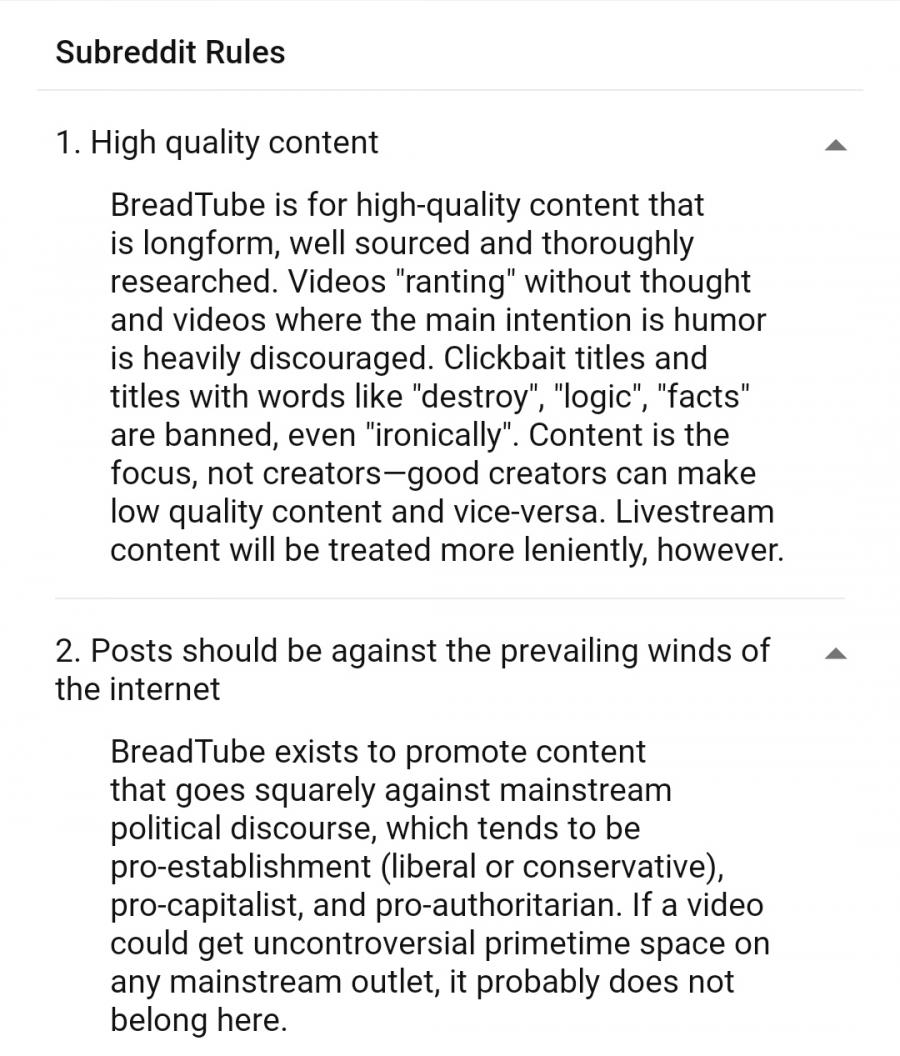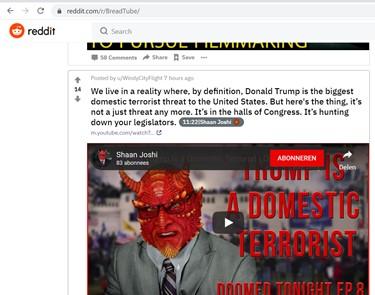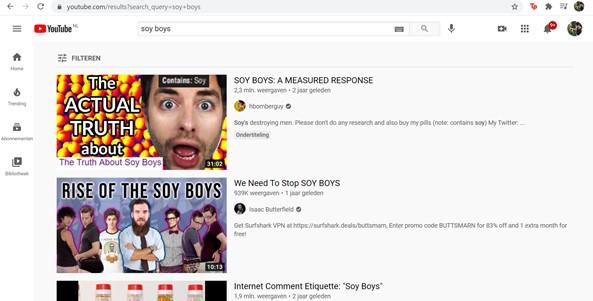
How BreadTube challenges right-wing discourse
In our current hybrid media system, older (mass media) and newer (social media) logics interact, and the complex relationships between actors are based on the power they exercise within this system: “actors create, tap, or steer information flows in ways that suit their goals and in ways that modify, enable, or disable others’ agency, across and between a range of older and newer media settings” (Chadwick, 2016).
The loose association of leftist independent online videographers, content creators, and their surrounding communities, dubbed ‘BreadTube’, try to do just that. These actors use new right, digital culture, and mainstream tactics to break into the hybrid media system's infromation flows to advance the spread of leftist ideas and, more importantly, hinder the diffusion of right-wing ideology.
By analysing these borrowed tactics, we can start to understand how BreadTube videos effectively challenge mainstream and right-wing discourses. However, analysing these tactics will also lay bare the weaknesses of BreadTube’s approach.
Using information from BreadTube creators, the r/BreadTube subreddit, and the article “YouTube as Praxis? On BreadTube and the Digital Propagation of Socialist Thought” (Ismangil & Kuznetsov, 2020), we will attempt to pinpoint what BreadTube is and what ideology underlies it. The data analyzed here primarily comes from YouTube videos by popular BreadTube creators. This definition of BreadTube and the ideology behind it will then serve as backdrop for an analysis of why some frequently recurring tactics in BreadTube content are successful in challenging new right and mainstream discourse.
What is BreadTube?
‘BreadTube’ (or ‘LeftTube’ as it is sometimes called) is described by Kuznetsov and Ismangil as “a loose association of independent online videographers and their surrounding communities that makes up a leftist response to alt-right use of digital media. The moniker Loose Association implies a lack of central organisation, of a structure that determines their relationships. Instead, a shared ideology binds them together” (Ismangil & Kuznetsov, 2020). The BreadTube community is not just limited to YouTube but stretches across multiple media platforms, such as Reddit, Discord and its own video aggregation site BreadTube.tv.

Figure 1) The first two r/BreadTube community rules
It is important to stress that, as the second rule of the r/BreadTube subreddit suggests, BreadTube content is not just a counterweight to the new right's usage of digital media, but it is also critical of mainstream ideology. We need to interpret mainstream ideology here as pro-establishment (liberal or conservative), pro-authoritarian, and, perhaps most importantly, pro-capitalist. This critique of mainstream ideology is one of the cornerstones of the shared ideology that keeps BreadTube, which is home to users and creators with a wide array of different political, leftist dispositions, from falling apart.
This shared leftist ideology has its roots in the tradition of the radical enlightenment, which promoted universal rights, democracy and radical equality, not just before the law, but socioeconomically as well (Israël, 2010). This form of democracy can only successfully be achieved when every citizen is educated on how to be democratic, which is why BreadTube has taken on the role of free educator for all: “BreadTube fills an ideological void for people who may lack the means and methods to educate themselves” (Ismangil & Kuznetsov, 2020). Viewers are encouraged to go beyond BreadTube videos and make use of the educational tools the community around these creators provides, such as discussion boards, book clubs and the dedicated discord channel for pirated or open access books and articles.

Figure 2) A smaller creator with 83 subscribers trending on r/BreadTube
To realize its ideal of equality between creators, BreadTube prioritizes the quality of content over creator popularity, as stated in the subreddit's rules. Furthermore, which works are accepted as BreadTube content is decided through democratic processes between users, such as discussions on forums or voting on Reddit (Ismangil & Kuznetsov, 2020). This is why you see videos from smaller creators, as shown in figure 2, as well as videos with leftist content from channels that typically do not revolve around this type of content, trending on the Reddit page alongside videos by bigger ‘BreadTube’ channels.
This is also in line with what some popular content creators from the community have stated. Not all popular ‘BreadTube’ creators self-identify as a BreadTuber, because, as T1J explains in the video above, the term is both creatively and politically limiting; it conditions you to strictly create essay style videos that are leftist, anti-capitalist and reactionary to the right in nature. The term is also often used by fans and journalists in reference to an elite group of popular leftist content creators, which makes the term a gatekeeper to the community.
However, just because the content selection process is decided democratically and many BreadTube videographers do not self-identify as such does not mean there is complete equality between creators. In a sense, top BreadTube creators function as ‘reluctant leaders’ or ‘anti-leaders’, who subscribe to an ideology of horizontalism and therefore do not want to be seen as leaders. Unlike Gerbaudo’s definition of ‘reluctant leaders’ or ‘anti-leaders’, they do not bring “a degree of coherence to people’s spontaneous & creative participation in protest movements” by virtue of scene-setting or scripting work (Gerbaudo, 2012). Instead, they render leftist content by smaller creators more meaningful by connecting it to a larger collective with a shared ideology. They also lead the way in discovering successful and innovative content creation tactics, raising the bar of what leftist content can be in the process.
BreadTube tactics
Content-wise, BreadTube videos are as diverse as their creators. While it is true that BreadTube videos are often explanatory videos, in which a broad topic is introduced and analyzed, or response videos, in which a right-wing or liberal talking point is debunked (Ismangil & Kuznetsov, 2020), every content creator has their own way of executing these types of videos. Some, like those by Philosophy Tube, are well-researched deep dives into specific topics, while others, like those by ContraPoints, use a discursive-dialectical technique to highlight various sides of a specific debate. There are also creators who primarily discuss topics from their own personal perspective, such as Kat Blaque.
Despite differences in the way videos are executed, certain techniques are often borrowed from mainstream and right-wing content and used across multiple popular leftist channels. These techniques have proven effective at breaking into the right-wing and mainstream information flows, allowing BreadTube videos to reach and hold the attention of traditionally mainstream and right-wing audiences, which in turn has the potential of challenging these audiences’ views.
Nostalgic Aesthetics

Figure 3) Bi-lighting used in the movie 'Atomic Blonde'
What does the blockbuster movie ‘Atomic Blonde’, Majid Jordan’s music video for ‘Small Talk’ and Philosophy Tube's livestreams have in common? They all use a lighting technique called bi-lighting (also known as bisexual lighting, in reference to the colors of the bisexual pride flag), in which a combination of pink, purple, and blue hues are used. The colour scheme originates from nightclubs and has been used in television and music videos as a subtle nod to the bisexuality of the character on screen.

Figure 4) The fake 80's aesthetic starterpack
Many will recognize bi-lighting in combination with bright neons and glitch effects as a nostalgic 80’s aesthetic. In actuality, the 80’s aesthetic is often confused with the more recent retro vaporwave aesthetic that emerged in the early 2010s. This style incorporates the previously mentioned visual elements as well as late 1990s web design, old cartoons and anime, 3D-rendered objects, cyberpunk elements, and consumer items to achieve a vague sense of surrealism and nostalgia.
Originally, the style was meant to ambiguously critique the hollowness of consumer capitalism, which eventually led to less ambiguous subgenres such as communist ‘laborwave.’ Due to this history of anti-capitalist usage, it makes sense for BreadTube and BreadTube creators to use the style as a motif in their leftist content, for example in r/BreadTube’s banner.

Figure 5) r/BreadTube's community banner
Although bi-lighting already overlapped the vaporwave aesthetic in colour scheme, its usage by BreadTube creators really took off when the technique also started gaining mainstream popularity. Not only does bi-lighting provide a way for BreadTube creators to pay homage to the (in origin) anti-capitalist vaporwave style, it is also a powerful tool for visually appealing to a broader mainstream audience, which may increase the uptake of the video. Lastly, this lighting technique can also serve an important symbolic function, such as in ContraPoints’ video “Tiffany Tumbles” (13:48), where it highlights the ideological differences between a conservative transgender woman and a progressive transwoman.
Internet Humour
The new right has long used trolling, harassment, and meme-culture to appeal to a young, tech-savvy audience who grew up online as part of their metapolitical strategy: “to do so, they purposefully craft a shared identity based on hipness and edginess, and they signify a countercultural identity that largely draws from youth movements of the past” (Lewis, 2018).
BreadTube creators have used meme- and internet-culture to appeal to that same young audience, while simultaneously poking through the edginess of right-wing arguments to critically look at them. In a New York Times article, ContraPoints states a similar idea: “I noticed that right-wing people were taking these old-fashioned, knee-jerk, reactionary politics and packing them as edgy punk rock. One of my goals was to take the excitement out of it.”
One video in which she clearly does this is “Are Traps Gay?”, which discusses the infamous internet debate about whether or not it is gay to be physically attracted to crossdressing men and/or transgender women, which further evolved into a debate on whether the question itself was unacceptably offensive or just a joke. ContraPoints not only looks seriously and critically at this debate, seen by many as merely a meme, but connects it to larger discussions on gender identity, fragile masculinity, and transphobia.
The approach clearly works, as evidenced by testimonies from formerly alt-right audience members. The same New York Times article writes of one of these audience members: “Unlike most progressives Mr. Cain had seen take on the right, Mr. Bonnell (Destiny) and Ms. Wynn (ContraPoints) were funny and engaging. They spoke the native language of YouTube, and they didn’t get outraged by far-right ideas.”
SEO
Search engine optimization is the umbrella term for a collection of strategies used to make content appear high up or frequently in search results. Digitally literate (meta)political influencers on the right have strategically used politicized keywords to market their content. Lewis (2018) also found that “influencers are explicitly using terminology affiliated with progressive social justice movements and are therefore appearing in search results for those terms.” In this way, right-wing (meta)political actors hijack progressive social justice movements' information flows to hinder their agency.
However, this also happens in the opposite direction. BreadTube content creators also consciously use right-wing terminology in their titles and other meta-content to tap into right-wing information flows. At the beginning of her previously mentioned video “Are Traps Gay?” ContraPoints explains why: “so we’re like a jogger, racing against a car. The only way to win is to hijack the car.” Using the term ‘trap’, despite its offensive connotation, allows her, a transgender woman, to hijack a conversation led by primarily straight white men.

Figure 6) Hbomberguy's video on Incels appears at the top of the search results
Using right-wing terminology in combination with high-quality, long-form content that appeals to a broad audience has proven to be a very successful formula for other BreadTube creators, like Hbomberguy (figure 6). Not only does their content appear at the top of search results, but there is also an increased chance that their content will be recommended by YouTube’s algorithm to those who have shown interest in right-wing topics, content, and content creators.
Problems facing BreadTube
The above-mentioned tactics are vital tools in appealing to a wide audience and, combined with the high quality of most BreadTube videos, are the reason for BreadTube’s initial and continued success. However, some of the tools and affordances that BreadTube relies on are founded on neoliberal principles, in complete contradiction with BreadTube’s anti-capitalist stance. This may have deeply troubling consequences.
YouTube, the video hosting site where most BreadTube videos are initially uploaded, is especially problematic. On Reddit, which content deserves the spotlight is decided democratically by users, and on BreadTube’s own video aggregation site, BreadTube.tv, videos are organized chronologically. However on YouTube, the content suggested to users is decided by algorithms that weigh numerous variables with the goal of keeping users on the site as long as possible, therefore increasing advertisement revenue. This is why YouTube is seen as a necessary evil if a leftist content creator wants to reach a large audience beyond just BreadTube users. This problem is also explained in BreadTube.tv’s about section:
“Services such as YouTube use hidden algorithms to serve content to users, the preferences of these algorithms are determined by YouTube's values, which as they are a subsidiary of Google is the generation of capital through advertising.”
Although the workings of YouTube’s algorithms are kept hidden, we can be fairly certain that one of the variables used is the relative weight or popularity of a creator. Van Dijck (2013), when discussing the work of Ding and colleagues on YouTube’s workings, noted this: “the unequal distribution of views among uploaders, as the researchers suggest, is hardly a matter of fair competition among users, but of YouTube tweaking its engine to benefit some heavyweight users.”
This, of course, causes the exact inequalities between BreadTube content creators that r/BreadTube is trying to avoid, mainly by focusing on the quality of submitted content rather than creator popularity. This issue is also reflected in the difference between what fans and journalists consider to be BreadTube and the definition given by r/BreadTube.
Within the community there is a fear of content creators taking advantage of BreadTube’s popularity and infrastructure for their own financial gain: “the incentive to being included as a part of LeftTube is fairly obvious. There’s an obvious financial upside, as well as an added bonus of extra media exposure that could potentially open up the door to more eyeballs being set on your content.” Popular, established creators within the BreadTube community are also frequently accused of exploiting their position to make a profit. In the video below, for example, content creator Shaun the Skeleton is criticized for his popular PragerU response videos, which, from the viewpoint of the critic, profit financially from the divide between the left and conservatives.
On the other end of the spectrum, smaller BreadTube creators are not able to financially support themselves with their videos. It is true that YouTube’s algorithms have generally preferred longer-form content in recent years, like r/BreadTube. However, unlike r/BreadTube, production value and how heavily researched a video is is not necessarily rewarded. Furthermore, YouTube values upload consistency, and for BreadTube creators who have a very high production value, like Philosophy Tube or ContraPoints, there are often weeks if not months between videos. This makes the platform unsustainable for smaller creators who want to make a living off of their content.
Patreon, Ko-fi or one-time PayPal donations can help alleviate some of these problems by providing smaller creators a way to earn extra income and bigger creators a way to not contribute to YouTube’s generation of capital. However, this does not eliminate the tightrope that BreadTube creators have to walk between not making a sustainable income and making too much profit from their work. Furthermore, Patreon, Ko-fi, and PayPal are also still for-profit services.
In other words, there are ways, like the r/BreadTube subreddit, to increase the equality between BreadTube creators and tactics, like SEO, to exploit the system to spread a leftist ideology. However, you cannot have a significant impact as a leftist content creator on the information flows of the right and mainstream without engaging in capitalism.
The paradox of mainstream integration
Borrowing techniques from the right and mainstream helps BreadTube creators break into their information flows, allowing their content to reach, keep the attention of, and challenge the viewpoints of a broader audience.
Unfortunately, this is a double-edged sword: to achieve maximum effectiveness, BreadTube creators need to play by the rules of the neoliberal affordances that they use, which goes completely against their anti-capitalist ideology. At the moment, the mentality of the end justifying the means still holds up, but the distrust between creators and their leftist base will only increase if creators continue to rely too heavily on the neoliberal system that they are trying to oppose. In the long term, this might damage the believability of BreadTube’s most important cornerstone: its shared ideology, potentially destabilizing the community as a whole.
References
Chadwick, A., Dennis, J., Smith, A. P. (2016). Politics in the Age of Hybrid Media: Power, Systems, and Media Logics. In Bruns, A., Enli, G., Skogerbø, E., Larsson, A. O., Christensen, C. (Eds.), (2016). The Routledge Companion to Social Media and Politics. Routledge
Ismangil, M. & Kuznetsov, D. (2020) YouTube as Praxis? On BreadTube and the Digital Propagation of Socialist Thought. Communication Capitalism & Critique, 18(1).
Israel, J. (2010). A revolution of the mind: Radical Enlightenment and the intellectual origins of modern democracy. Princeton University Press
Gerbaudo, P. (2012). Tweets and the streets: Social media and contemporary activism. Pluto Press
Lewis, R. (2018). The alternative Influence Network. Broadcasting the Reactionary Right on YouTube. Data & Society
Van Dijck, J. (2013). The culture of connectivity. A critical history of social media. Oxford University Press.